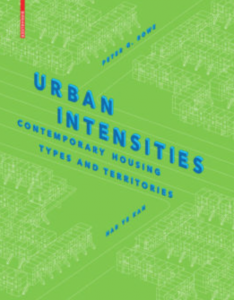Urban Intensities: Contemporary Housing Types and Territories

Author: Peter G. Rowe
Author: Har Ye Kan
Birkhauser, 2014
Combining the architectural and urban scales, this book demonstrates that it is a specific quality, urban intensity, which can determine the success of housing. It provides a typology of housing according to the ways in which diversity and density are created, drawing on comparisons with historical models while offering critical appraisals of the pitfalls and successes of contemporary housing projects. The international case studies that serve as central examples in each chapter are described and analyzed in detail, and are accompanied by newly created drawings ranging from floor plans and unit types to views of the projects within their urban contexts.
As used in the book, ‘urban intensity’ is to be understood as a function simultaneously of density, diverysity, and connectivity in urban circumstances. It is through the interaction of these three properties of urbanity that inject vitality, vigor, and a certain keenness to the reception of a place, or at least this possibility. In this context, ‘density’ refers to dwelling density, although it by itself does not guarantee either dynamism or healthy intensity in a city. ‘Diversity’ is manifested through several ways. First, at the level of specific housing complexes, it refers to the additional magnitude and range of non-residential uses that are included. Second, it refers to both variety in the different kinds of dwelling units within a particular project and provision, or not, of flexibility within those units for accommodating different day-to-day, occasional, or lifecycle aspects of occupation and use. Third, in terms of demand for housing provision, diversity can also refer to fluctuations and rises in household formation of different types, thus driving the need on the supply side of housing towards more diverse unit types as well as poly-functional arrangements. ‘Connectivity’ refers to two aspects in this context. The first is proximity and ease of access to other parts of a housing complex, including support functions and non-residential uses, as well as the provision of places and occasions for ‘neighboring’ among dwellers within the same residential environment, should that be deemed desirable. The second is the manner in which the housing projects are situated in the broader urban contexts, especially with regard to transport access, neighborhood community facilities, stores, public open-space amenities and the like.
What follows are nine chapters, each dealing with a particular typal and territorial category. These include ‘Urban Block Shapers’, ‘Housing and Landscapes’, ‘Superblock Configurations’, ‘Tall Towers’, ‘Big Buildings and Submultiples’, ‘Infrastructural Engagements’, ‘Indigenous Reinterpretations’, ‘Infill and Puntal Interventions’, and ‘Housing Special Populations’. Through an examination of projects in these various types, the book suggests that contemporary urban housing follows a turning point in its form, appearance, and urban disposition generally since the 1990s or thereabouts.